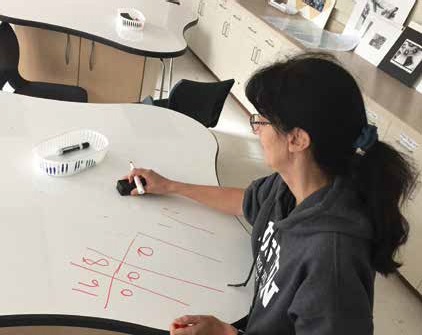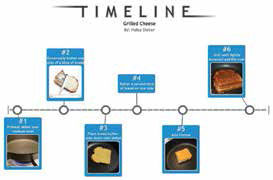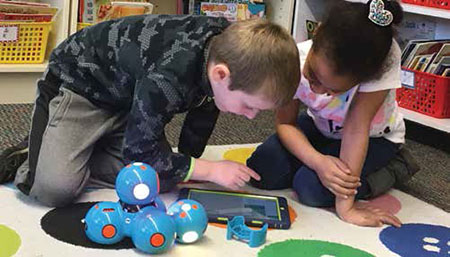CALLING ALL CODERS

By 2018, there will be more than two million open jobs in STEM (science, technology, engineering, math) professions, but only 19 percent of current college degrees are in STEM fields. Even worse, 75 percent of students that do well in science and math decide to not pursue STEM in college. If we want to remain a global leader, we have to develop more interest in these topics. One way to do that is by to show students that coding ties into nearly everything we do. And to do that, we need to incorporate programming into the curriculum, just as they’ve done in the following examples.
PROGRAMMING FOR ALL

At the South Bronx Early College Academy, a public charter school for grades six and seven, computational thinking is woven into every class. “I joined this school to help bring computer science into the core and make a difference,” says computer science teacher Kelly Powers, who has been involved in programming since 2005. “Our students do computational-thinking activities that develop their problem-solving and analytical skills and push them to think creatively.” Last year, Powers worked with the physical education teacher on a unit in which students collected data to determine how fitness and good nutrition helped them grow. In Powers’ classes, students learn how to approach a problem, about the tools that can help solve problems more efficiently, and then go about solving those problems. They learn how to program with Scratch (scratch.mit.edu) and AgentCubes (www.agentcubesonline.com) and create their own games. Recently, Powers worked with her colleagues to bring inquiries into their classrooms. She and the science teacher taught students to use Python (www.python.org) to chart climate data, create graphs, and reflected on their graphs. Literature students made Scratch animations about Theseus. “When they do these kinds of projects, they make all sorts of connections and reinforce their learning,” says Powers. “We spend lots of time brainstorming and decomposing problems into smaller chunks. We want our students to discover new ways to solve problems using a variety of tools.” Powers is determined to spread her love of programming because our world is driven by technology. “Any careers my students go into will be rooted in computer science. By learning to use programming languages to come up with solutions, they’ll be prepared for any field they choose.”
MAKING A STATEWIDE IMPACT

The state of Virginia is determined to expose its students to programming and has formed a computer science steering committee that is creating computer science standards for grades K–12. “In 2016, we became the first state to include computer science as part of the curriculum in all schools,” says Deborah Marshall, department chair for Career & Technical Education at Granby High School in Norfolk, VA, and a member of the state’s steering committee. Two of her district’s high schools teach IT Fundamentals, and it will be offered at all five high schools soon. Part of the challenge for many districts is finding and training teachers who can teach coding, but in Virginia that’s being addressed by CODEVA (www.codevirginia.org), a nonprofit organization that offers free teacher training and meetups for teachers who can’t attend CODEVA training but are interested in learning more about integrating computer science and coding activities into their courses. Marshall and her colleague, a digital marketing teacher, hosted a CODEVA meetup at their school; CODEVA is planning to sponsor these events in other regions of Virginia. Marshall’s district participates in Hour of Code and Digital Learning Day, and students received coding lessons for the entire month of December. She helps students make connections between programming and the real world so they can recognize the importance of coding and understand that it’s not just one more thing a teacher makes them do. According to Marshall, 80 percent of Granby High School students have done some form of coding, whether in a class or an after-school program.
CODING IS ELEMENTARY

Three years ago, Quaker Hill Elementary School participated in Hour of Code. “It was the first experience for our building and staff,” says Robyn McKenney, K-5 technology coordinator for Waterford (CT) Public Schools. “We didn’t even know what coding was,” says Whitney Wadecki, a first-grade teacher at Quaker Hill. Since then, all three Waterford elementary schools are doing Hour of Code, there’s a coding club for grades K and 1, and Wadecki created an eight-week course based on Code.org’s curriculum. “The first year of the coding club, I had 30 members and a waiting list of 30 more,” says Wadecki. Now in its third year, she runs the club for two four-week sessions and is up to 45 attendees each time. Wadecki and McKenney also do programming activities in classrooms and in the computer lab. “Robyn and I shared robots and Beebots (www.bee-bot.us) with classrooms to build momentum. The children were so excited that the PTAs in each school purchased robots for their labs and teachers.” McKenney set up an Innovation Station in the computer labs; students rotate through 11 different areas to fly drones and program robots. “The activities we plan help children improve their skills in problem solving, collaboration, and critical thinking. They are engaged and excited.” Coding and robots are integrated throughout the curriculum. Students used Sratch Jr. (www.scratchjr.org/teach.html) at math stations, use Blockly (developers.google.com/blockly) to animate robots, and commands to make Beebots pull wagons. Fifth-grade classes worked in groups to build snow plows with Dash and Dot (www.makewonder.com). “They had to work together and problem solve, which they did because the challenge of getting it to work was so magical,” says McKenney.
Tools and ideas to transform education. Sign up below.
CODING PREPARES STUDENTS FOR EVERYTHING

Web design teacher Luna Ramirez teaches coding in all of her classes at Information Technology High School in Long Island City, NY. “I focus on the vocational aspect of coding,” she says. “How will the skills I teach help students in their career or profession after high school?” Ramirez, who teaches HTML, JavaScript, CSS, and jQuery, says the concepts of programming are good in any subject, since they prepare students to develop ideas and use the code to provide the answer. The school has a web design academy and a video production academy. In the first year of web design, students learn Adobe tools; in their second year, they learn about data, globalization, coding, and programming. In digital design, students learn how to design web pages, how to connect to STP servers, and more. Before graduation, they do an internship and have a portfolio (see samples, at right). Ramirez gives her students problems to which they must use their skills to find solutions. “Technology is taking over all jobs, even trucking—all trucks will be driven by computer programs in a few years. If you don’t know coding, you won’t have a job,” she says. “When you’re coding, you have to spend hours to troubleshoot if it doesn’t work. It builds up endurance and perseverance. You have to be patient and pay attention to detail. Those soft skills are vital for everyone, and you can only get those skill from programming.”
